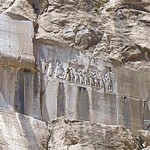- Latest Archaeology Updates
- Importance and applicability
- Famous Archaeologists
- Museums Collections
- Site Map
- World Heritage Sites
- World History Monuments
- Archaeological Organizations
- World Atlas of Archaeology
- Forensic Investigation and Geophysics
- Contact Us
- Movies based on Archaeology
- Frequently Asked Questions
- Archaeological discoveries
- Tell a Friend
- Archaeological Abbreviations
- Gallery Collections
- Famous-Museums site map
- Famous-archaeologists site map
- Archaeological Monuments site map
Bisotun is present along the ancient trade route linking the Iranian high plateau with Mesopotamia and features stays from the prehistoric period to the Median, Achaemenid, Sassanian, and Ilkhanid periods.
The principal monument of this archaeological site is the bas-relief and cuneiform inscription arranged by Darius I, The Great, when he rose to the throne of the Persian Empire, 521 BC.
The bas-relief portrays Darius has a bow, as a sign of sovereignty, and treading on the chest of a figure who lies on his back before him.
According to legend, the figure explains Gaumata, the Median Magus and pretender to the throne whose assassination led to Darius’s rise to power.
Below and around the bas-reliefs, there are ca. 1,200 lines of inscriptions showing the story of the battles Darius waged in 521-520 BC against the governors who has been to take apart the Empire founded by Cyrus.The inscription is written in three languages.

